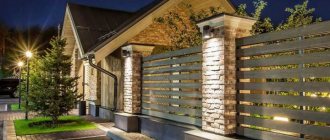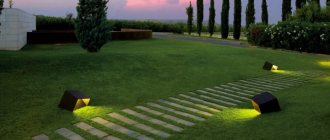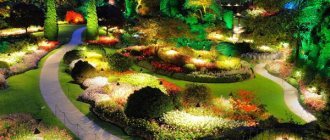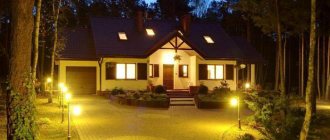03/21/2016 master
Lighting is an indispensable component of the modern world. With the accelerated pace of urbanization, the topic of street lighting is becoming relevant. Today you can find a wide variety of lanterns on city streets.
Lamps that will work outdoors have their own requirements. This is due to the fact that here the lanterns are influenced by various climatic conditions, which can negatively affect their quality and duration of operation. You will learn about the requirements and other aspects of creating modern street lighting from this article.
Purpose of devices
Street lights are a necessity in any modern city. With the popularization of the trend of environmental friendliness and safety, an increasing number of people prefer to live outside the city limits in the suburbs or the private sector. Therefore, in such a situation, the issue of ensuring effective and adequate street lighting becomes relevant. Here street lights will perform the following functions:
- lighting the space near the fence and gates;
- street lighting along the roadway to reduce the risk of a car accident and injury to people when moving along the sidewalk;
- as an element of the security system.
Note! Very often, street lighting is used in a security system. Such lights are additionally equipped with sensors that respond to movement.
Motion sensors
As you can see, the presence of street lighting is an objective necessity, which cannot be avoided in modern society. Its creation is the responsibility of territory improvement by municipal organizations and individuals.
Installation process
First you need to dig a hole of the required depth and width in the place where the lamp will stand. A layer of sand is poured onto the bottom and compacted well. Then a wooden box (formwork) is made from boards and nails to fit the width and depth of the hole in the soil. A special plastic pipe is placed in the center of the formwork, through which the electrical cable will later be pulled. The formwork is poured with concrete. When the concrete hardens, the boards are removed and the cable is pulled through the pipe. The structure is lowered into the pit. Next, attach the post, install the lamp, connect the wires and connect the lamp to the electrical network.
Creation requirements
When designing street lighting, you need to know that here, as in rooms, there are certain requirements that the lamps must meet. The most important parameters here will be:
- lamp power. This parameter is measured in Watts;
- luminous flux that a lamp emits. This indicator is measured in Lumens.
LED flashlight
The efficiency with which modern street lights operate is measured in terms of Lumens to Watts. The higher the final result, the greater the efficiency of the lighting device. Note! The LED street lamp has an efficiency of 100 (100 Lumens/1 Watt). Therefore, it is precisely such lamps that can be found today on the streets of cities and towns.
All lighting standards that should be on the streets are regulated by the normative documentation of SNiP. According to this document, street lamps must create the following lighting in various areas of the city:
- in parks and pedestrian paths, the light should be diffused. Therefore, the lanterns here must be equipped with a special shade;
- information objects on residential buildings and government institutions (names of structures, house number, street, etc.) should be well illuminated. To do this, use spotlights with bright bulbs. Roads and highways need to be illuminated in the same way;
- architectural structures of a decorative nature (gazebos, building facades, various sculptures, etc.) can be illuminated by a variety of spotlights or lanterns.
In addition, luminaires must meet certain technical characteristics, safety standards and overall design. Due to the fact that they work outdoors, where sudden temperature changes and high humidity are possible, street lighting fixtures must meet the following requirements:
- resistance to various climatic conditions;
- long period of operation;
- the ability to protect lamps using anti-vandal systems;
- efficiency in terms of electricity consumption;
- practical and discreet design;
Note! Lanterns installed on the street should not distract drivers and passers-by with their design delights. Otherwise, it is fraught with an accident.
Lantern design
- ⦁ ease of maintenance.
Only if the above requirements are taken into account will street lighting be of high quality, efficient and practical.
Bracket angle
Another important nuance, the existence of which is often discovered too late: at what angle the holder should be bent.
- Standard models are presented in the range of 9-15 degrees. But in an individual order, you can make a console of any acceptable angle.
- When purchasing, be sure to check with the seller where the light flux will be directed when installing the console.
- This can be approximately determined by making a simple drawing. And exact data is contained in the instructions for each console lamp.
What to consider when choosing
In addition to the above parameters, when choosing a lighting device for street lighting, you should take into account:
- climatic conditions that are typical for the illuminated area;
- assessment of the possible negative impact of the environment on the service life of lamps;
- the intensity of the luminous flux within the radius of the received illumination;
- installation features of the lighting device;
- requirements of the territory that needs to be illuminated in terms of luminous brightness.
At the same time, the climatic features of the installation site play a very important role in the process of choosing outdoor lamps . Depending on them, the required level of protection of lighting devices from moisture, dust, as well as possible mechanical damage is determined.
Self-installation of the lantern
You don't have to take any particularly complicated actions . The simplest knowledge of electrical rules is enough. If there are none at all, it is better to invite a specialist for such work to avoid troubles. It is also better to entrust the installation of an extensive network of lanterns to a specialist, because you will have to not only install the lanterns and conduct electricity to them, but also calculate the radius of lighting, its strength and other important details.
And you can install several small lamps yourself without any problems. First, you should know a few important installation aspects:
- Lanterns should not shine directly into the windows, otherwise it will be difficult to sleep at night.
- It is unprofitable to place several lamps one step away from each other. They should be distributed relatively evenly.
- Lighting should not extend into other areas.
- Switches should be reliably protected from moisture with special plastic boxes.
The cord also needs to be well protected, but not from moisture, but from cutting . If the cable is laid underground, it should be additionally protected from mechanical damage during landscaping and agricultural work.
The cord is placed in a special protective tube. And for the safety of the pipe with the cord, it is recommended to pour a layer of pebbles on top.
Variety of choices
Floor lamp
Modern lamps that are installed on the streets come in a wide variety of types. According to their intended purpose, such lamps can be as follows:
- floor lamps. A special feature of lighting fixtures is their installation on a support. As a result, they emit light from above. These are traditional lamps that are most often found on the streets. They are used to provide lighting for courtyards, pedestrian areas, parks, boulevards, squares and suburban areas;
Note! Floor lamps can be single- or multi-arm. In this case, the height of the support can also vary over a fairly wide range. They can be practical and decorative.
Facade lamps
- façade lanterns. They are also called cantilever lamps. Such lamps are attached to the facades of buildings using special brackets or supports. This type of lighting fixtures often has a beautiful and ornate appearance, as they act as additional decoration for buildings. They serve to illuminate house numbers and other information signs;
- landscape lights. The most numerous and diverse group of street lighting devices. These lamps can have different designs, designs and colors. For example, such a lamp may have the shape of a garden figure. Very often, with their help, various installations are created to illuminate parks and squares;
Landscape lamp
- main street lights. Such lighting devices are placed along highways and highways. They can illuminate the largest area around them (up to 9 m). In this case, the lighting will be bright. The standard interval between such lamps is from 5 to 20 m. The distance is affected by the power and number of lamps, as well as the height of the column;
Main luminaires
Advertising lamps
- advertising or banner lights. These modern lighting devices have appeared relatively recently. They are used to create outdoor advertising lighting. They are characterized by an inconspicuous design and high luminous flux power.
As you can see, the variety of street lighting is quite large. Each type of lamp has its own characteristics and illuminates the street to a specific area as efficiently as possible.
Based on inert gases
Gas discharge lamps are the general name for a large class of devices. The synonymous name is luminescent. The operating principle is the same: gas glows under the influence of charged particles.
- A noble gas, for example, xenon, argon, neon, is pumped inside the flask.
- Accordingly, the lamp may have a narrower name: neon, xenon, etc.
- In addition to gas, the lamp must contain additional metals, most often sodium or mercury.
- Therefore, in articles you can find how gas-discharge lamps are called sodium or mercury.
The general advantages of this class are long service life and high efficiency.
Variety of lamps
In addition to having a huge range of street lights, such lighting fixtures can vary depending on the type of light source used. Today, the following types of light bulbs are used in street lamps:
- incandescent lamps. The most rare type of light bulbs, as they are characterized by high energy consumption. The advantages include high heat transfer and power;
- halogen bulbs. The positive aspects of operation include a long service life. Used in floodlights and lanterns of various types;
- metal halide lamps. Due to their high light transmission and power, they are used to illuminate large spaces;
- gas discharge lamps. They are characterized by high light output efficiency and a long service life. Among the disadvantages, it is worth noting the noise of operation and the possibility of flickering. But these disadvantages are not fundamental for the street. Very often used for street lighting, especially decorative;
Types of light bulbs
- mercury lamps. In street lighting they are used as general purpose light sources. Disadvantages of operation include the need for heat-resistant insulation of wires, heating during operation, which can fail due to voltage surges;
- sodium light bulbs. Such light sources have low spectral characteristics. The glow spectrum is yellow-orange. In addition, the light from them is soft, which allows them to be used to illuminate city streets;
- fluorescent lamps. They have high light output and a long service life. Today they are actively used for street lighting
- LED lightening. The most popular light source in modern cities and villages. Their positive characteristics, such as energy efficiency, excellent luminous flux and long service life, speak for themselves.
Solar lighting
The above-described light bulbs will have the greatest efficiency and economy when connected to motion sensors. Separately, it is worth noting that recently on city streets one can see the active use of eco-innovations - solar panels. Such models are lighting devices of a new generation, as they are characterized by great efficiency.
But this type of lighting at this point in time can be found mainly near houses, landscape and architectural compositions. Such lanterns act as an alternative to the above methods of illuminating the streets of cities and towns.
Smart lighting
To automate the processes of turning on/off lighting in order to save energy, the following are used:
- photo relay - turns on the light source at dusk and turns off at dawn;
- astronomical relay - switches the device based not on the light level, but on the geographic coordinates of the area, which are entered manually;
- motion sensor – turns on the lighting when motion is detected in a given range;
- temporary relay – provides for manual activation of the system and automatic shutdown after a specified time period.
Design Features
Modern street lamps, depending on their purpose, can have a simple or sophisticated design. They can be made in both modern styles and antique styles. The following types of materials are used to create them:
- steel;
- plastic;
- glass;
- forging.
Design option
The most beautiful and elaborate will be façade and landscape lighting models. With their help you can effectively decorate a park area or a private garden. But all other types of lanterns (floor lamps, main lamps, advertising lamps, etc.) are characterized by greater practicality and simplicity of design. Modern street lamps can have different designs, purposes, designs and light sources. The correct selection of all these parameters will allow you to choose the lantern that will most effectively cope with the task assigned to it in illuminating the surrounding area.
LED
Lamps with non-removable LEDs or replaceable LED strip. You can also find the English name LED, that is, light-emitting diode.
There is also an option for a solid LED lamp that is mounted on a bracket.
Such designs are called cantilever lamps.
- For lighting large areas, entrances and places that are difficult to regularly maintain, such products will be a real boon.
- Their operating time reaches 50 thousand hours, and during this time the structure practically does not require maintenance.
- If one or more diodes fail, the operation of the others is not affected.
Purpose of garden lamps
Modern landscape design cannot be imagined without lighting fixtures; garden lamps are a proven means of organizing the space around the house and garden area. The use of garden lights is beneficial in solving several problems:
- Creating a stylish environment . Lamps participate in the design of the landscape, making it harmonious and individual. For this purpose, they are installed near fences, paths, fountains, benches, and reservoirs (including under water). A classic design technique is illumination of the facade of a building, installing lamps along the wall, balustrade or in the steps of the house.
Multi-level lighting Source landshaftnyj-dizain.com
- Safety at night . It’s easy to navigate in the light of the lamps, avoid a low-lying branch, and avoid tripping or tripping on steps. If ensuring safe movement is the main task, then lighting fixtures illuminate the gate, gate and entrance to the house. Installed along the paths, they will indicate the direction of movement; the lights will also help you park your car and mark the boundaries of the site.
To avoid tripping Source mojhoroskop.club
- Evening rest . The soft light emitted by garden lanterns will push away the dark country night, create an atmosphere of comfort and lift your spirits. For comfortable spending time in the fresh air, lamps are installed in the recreation area, next to the gazebo, swing, playground or hammock.
Comfortable rest in the evening Source realsimple.com
Lighting standards in parks and squares
External lighting of green urban areas is carried out taking into account the status of the object, its area and landscaping. For small squares, simple lighting schemes are used - uniform installation of the same type of lights around the perimeter and at key points: steps, paths, turns, benches, children's and sports grounds. To illuminate large parks, combined systems are used, which include lamps of different types and purposes.
The number, lighting characteristics and location of lighting fixtures are not regulated. The main requirement for artificial lighting in parks or public gardens is that it must comply with federal sanitary and hygienic standards. Particular attention is paid to the level of illumination of the territory. This parameter depends on the functional purpose of a certain zone and is determined by SP 52.13330.2016:
- main entrance to the park – 6 lux;
- central alleys – 4 lux;
- secondary entrances and paths – 2 lux;
- public recreation areas – 10 lux.











